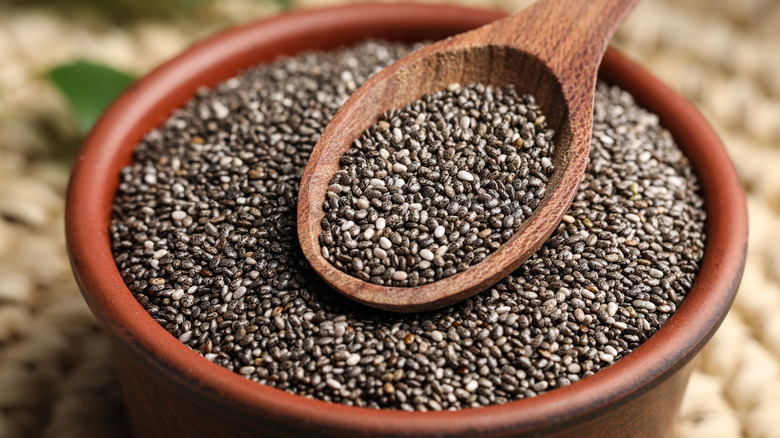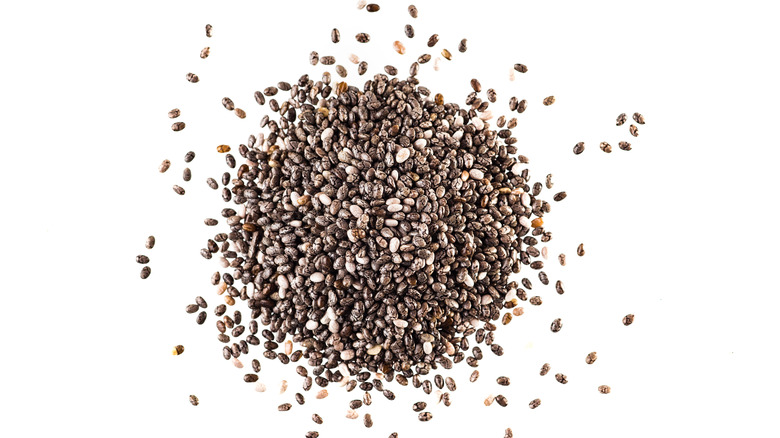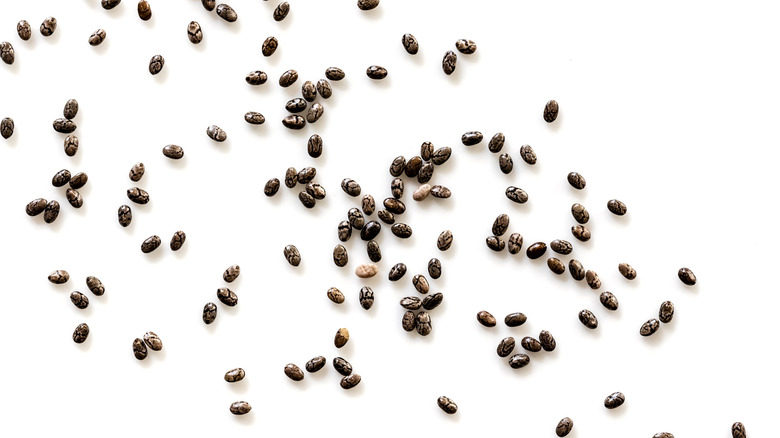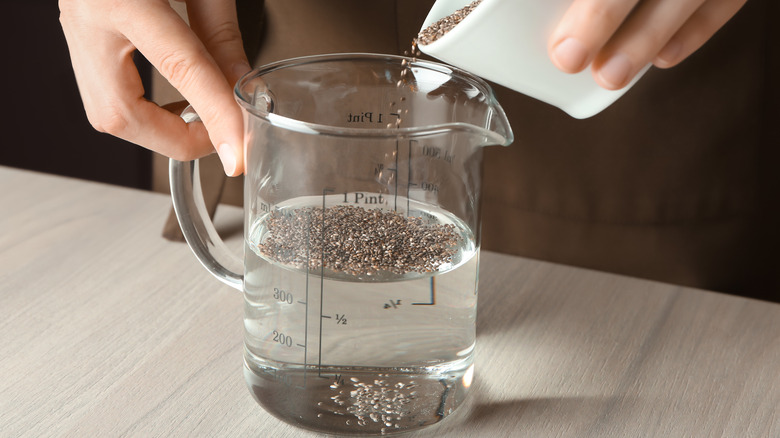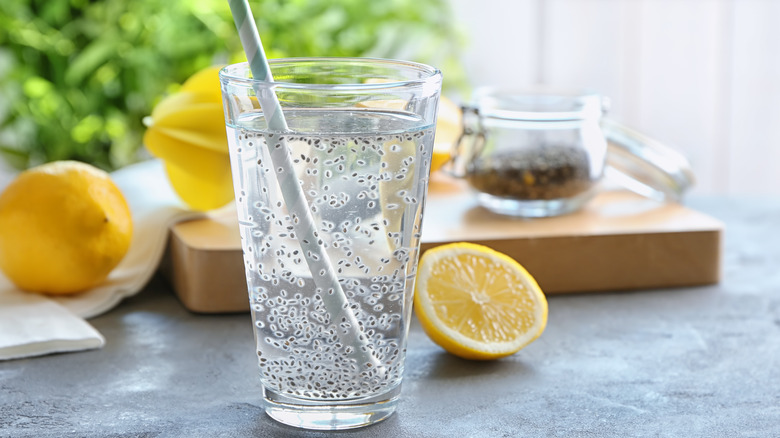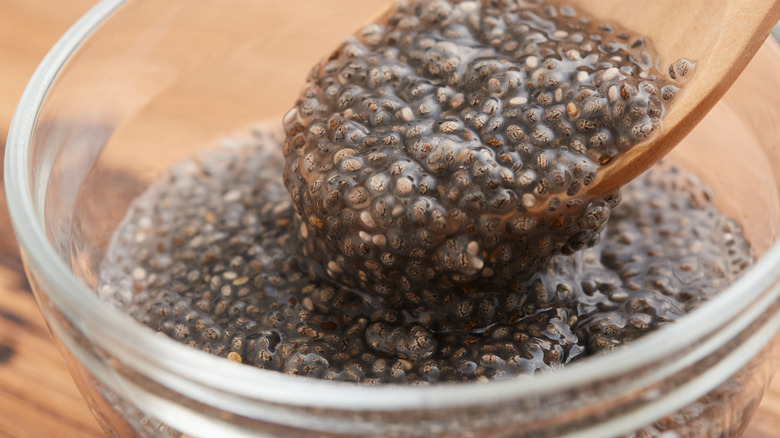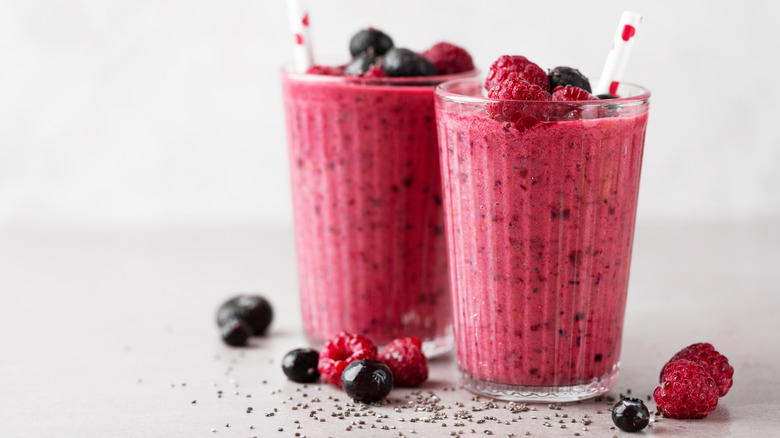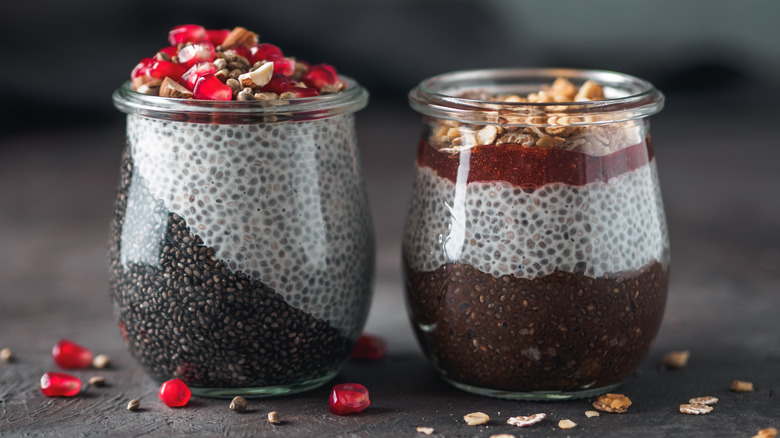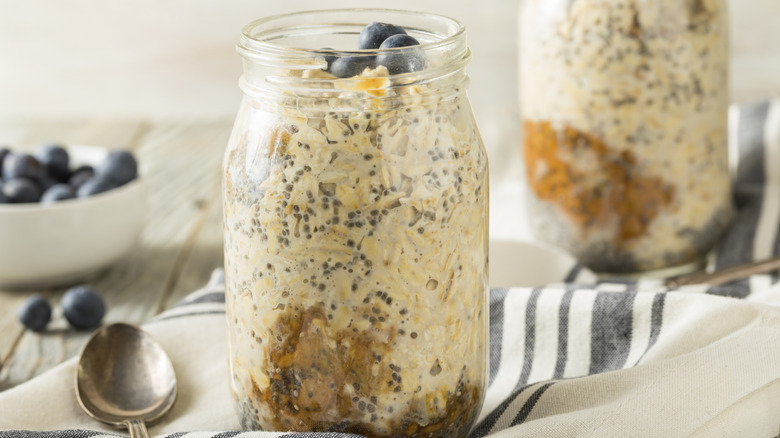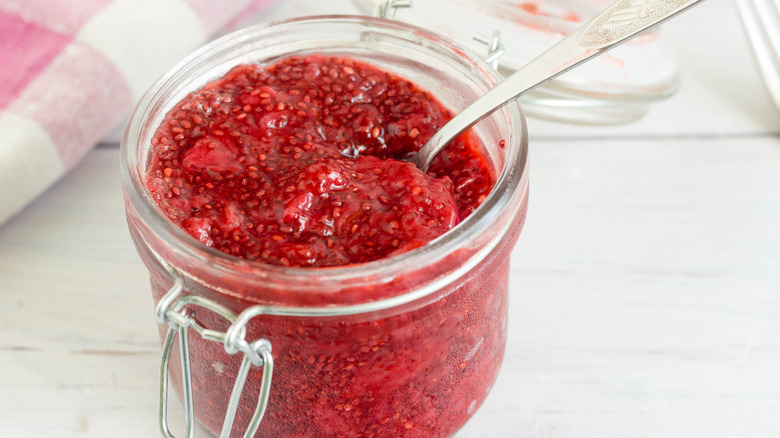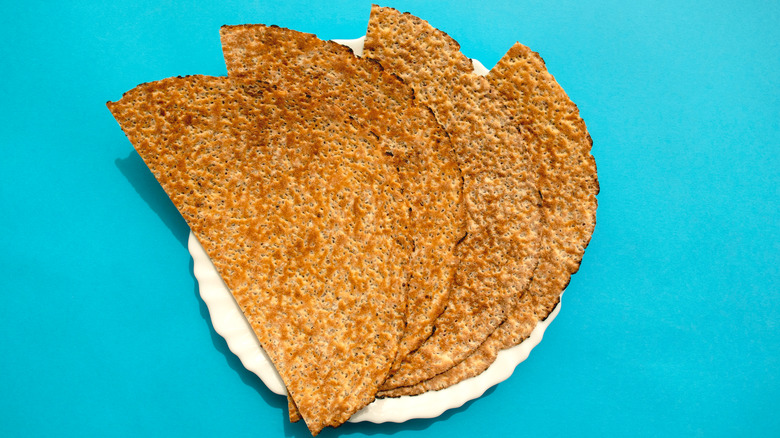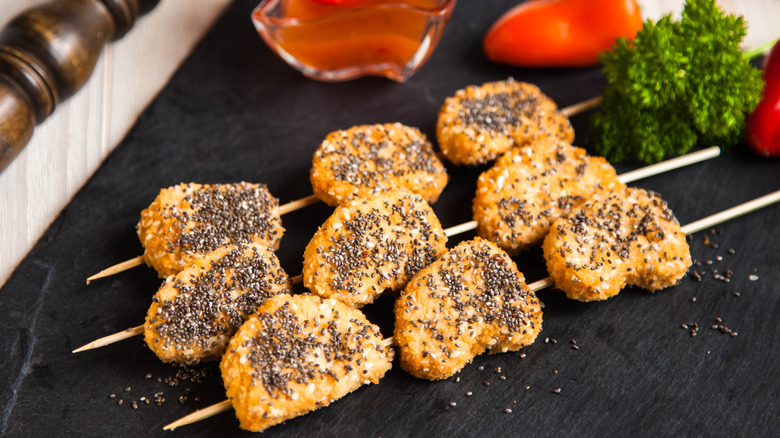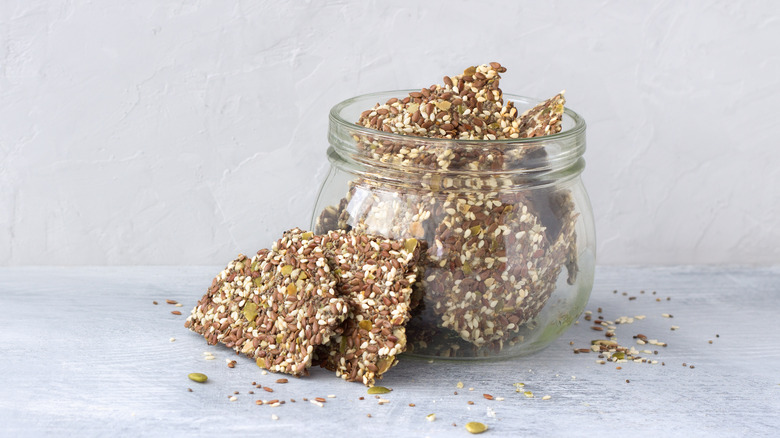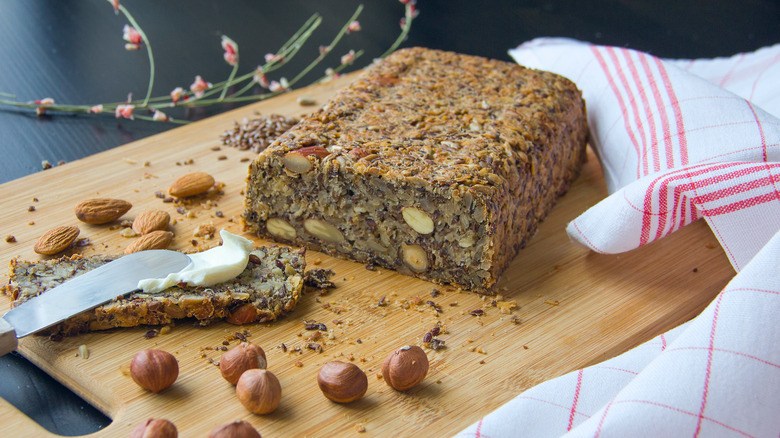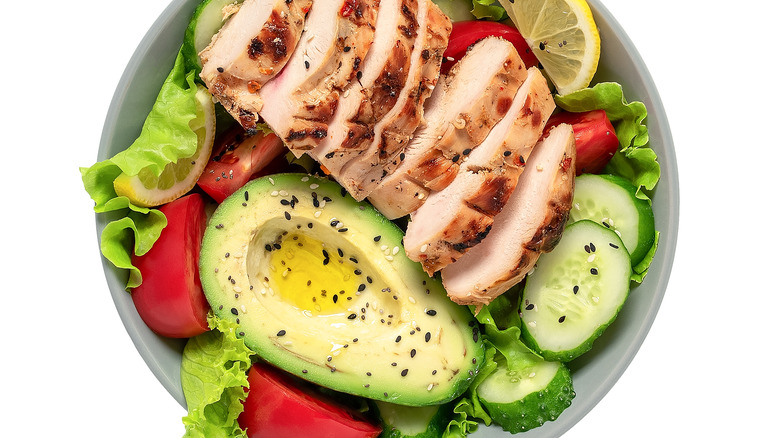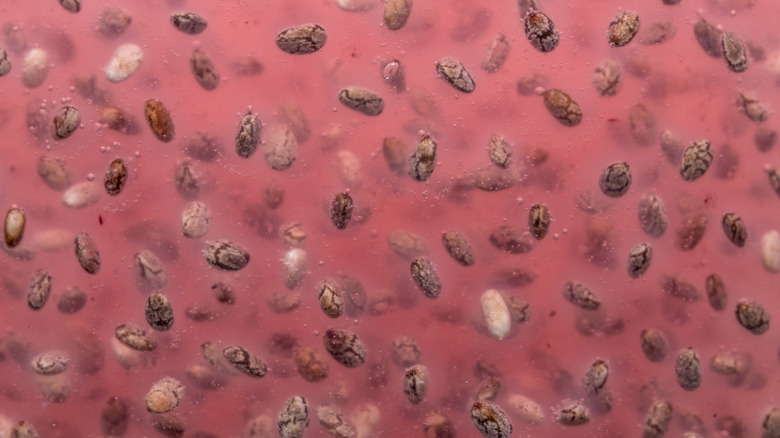How To Cook With Chia Seeds
Chia seeds are the seed of an annual plant called Salvia hispanica, which is a member of the mint family. Chia flowers are pretty, white, and purple, but people mostly grow the plant for its seeds. The seeds come in a few colors, which range on a scale from white to black. Chia is a reasonably versatile ingredient because its nutty flavor is pretty mild.
Where do chia seeds come from? According to the National Library of Medicine, they are native to Mexico and Guatemala. Both Aztecs and the Mayans used them to make medicine and food. Aztecs, in particular, also used them in cosmetics and religious ceremonies. The word chia can be traced back to the Mayan word chiháan, which means strong or strengthening (via Merriam-Webster).
These days, chia seeds are grown all over the world. While Mexico is still the world's largest producer, Australia, the U.S., and several countries in Europe and South America also produce this tiny seed. That's because many people consider it a superfood, and its oil is highly prized. But, is chia a superfood? Can you eat too much of it? And how exactly do you cook with it? Never fear; we're here to answer all those questions!
Are chia seeds a superfood?
Are there benefits to adding chia seeds to your diet? According to the National Library of Medicine, chia seeds are a nutritional powerhouse. To begin with, chia is gluten-free and a good source of fiber, protein, and fats. That makes it a great addition to paleo and keto diets. Additionally, as a source of omega-3, -6, and ALA fatty acids, chia seeds can help supplement vegan or plant-based diets.
But chia seeds' nutritional kick doesn't end there. This tiny dynamo is packed with vitamins A, B, D, E, and K, as well as magnesium, phosphorous, calcium, potassium, and antioxidants. Eating chia seeds may help improve overall health, which includes strengthening bones and muscles and aiding the digestive system. And Healthline notes that chia seeds' omega-3 content may even help lower anxiety.
Scientists say that the health benefits between the different chia seed colors are minimal at best (though it does seem black seeds "win" by a small margin). However, other preparation methods, such as soaking or sprouting, change how much of which nutrients your body can absorb, so to get the most bang for your buck, try out a few different recipes on this list (via the National Library of Medicine). Of course, as always, consult with your doctor before adding chia seeds to your diet.
Too much of a good thing?
The old wisdom that you can have too much of a good thing certainly applies to chia seeds. It's important to remember that while chia seeds are pretty allergen-friendly (they're gluten- and nut-free), it is certainly possible to be allergic to chia. Scientists have found that people with sesame seed allergies may be more sensitive to chia seeds, per the National Library of Medicine.
Chia seeds have incredible liquid absorption power — they can soak up to 27 times their weight (via The American College of Gastroenterology). But that can be a double-edged sword; while that ability is great culinarily, it creates a huge choking hazard, especially for people who already have problems swallowing. If you fall into this category, you shouldn't eat dry chia seeds because they can get stuck in your throat and expand there, creating blockages.
Additionally, since chia seeds have a lot of fiber, they may cause cramping or other digestive issues, especially in people with conditions such as Crohn's disease, notes Healthline. Since chia seeds can lower blood sugar and blood pressure, it's possible they can interact with medications intended to do either of these things. With all that in mind, Healthline recommends a dose of 0.7 ounces of chia seeds twice daily. As with anything, this will depend on your health needs, so work with your doctor to decide what's best for you.
Do you need to soak chia seeds before you eat them?
You don't necessarily have to soak your chia seeds before eating them, but doing so can help prevent blockages in your throat or intestines, reports Livestrong. Some people insist you do need to soak your chia seeds, but there are a few applications for which you'd use un-soaked chia seeds. In small amounts, unless you have a medical reason to avoid un-soaked seeds, you'll likely be fine to skip the soaking.
Or, if you're making chia seed flour, for example, the "soaking" happens when the chia comes in contact with liquids during the cooking process. That said, there are uses for chia seeds requiring soaking or soaking chia seeds as part of the cooking process. It completely changes the texture, for the seeds release a slimy gum, which is way more appetizing than it sounds (via the International Journal of Food Science).
Drink chia water
Some people mix chia seeds and water as a way to get the health benefits of chia seeds. In fact, this method of consuming chia seeds was at one point a TikTok trend. But why? Well, this water is considered an appetite suppressant, so even though it doesn't cause weight loss, it might keep people fuller longer, thereby keeping them from eating more than they'd like. Drinking your chia seed water at night could help you avoid reaching for a midnight snack, per Healthline.
To make chia seed water, all you need to do is put about a tablespoon of chia seeds in a glass of water. Then, let that sit for half an hour before enjoying it. You can add some lemon, lime, or honey for a touch of flavor if you'd like. Even if you're not looking for an appetite suppressant, chia seed water is a great, refreshing way to reap the nutritional benefits of this food.
Substitute chia seeds for eggs
Chia seeds are one of the absolute best egg substitutes out there. We recommend using them in baked goods, especially those that are a darker color treat, like brownies or pumpkin bread. That's because their dark color will be visible in pancakes or yellow cake — but, hey, you do you.
To make a chia seed egg, all you need to do is use 1 tablespoon of ground chia and 2.5 tablespoons of water for every egg your recipe needs. Mix the water and seeds. Let them sit for at least five minutes. Once the mixture looks gelatinous and eggy, add it to your batter.
Chia seeds make wonderful eggs because the slimy gum that's released when it mixes with water is a wonderful binder. According to the International Journal of Food Science, chia gum is likely held in the seed coat or in a close-by layer.
Mix them into your smoothies
Ahh, who doesn't love a delicious, creamy, fruity smoothie on a hot day? Whether you're enjoying it for breakfast or as a snack, make sure you're not committing one of these mistakes that everyone makes when making smoothies. Believe it or not, chia seeds can even help you out here, too.
Adding chia seeds — or another healthy fat — to your smoothie maximizes its nutritional potential. Some vitamins require fats to be fully absorbed. And healthy fats can help slow down the blood sugar spike that may accompany a fruit smoothie, and you will stay fuller longer. To add chia seeds to a yummy fruit smoothie, soak them first so that they can also serve as a binding agent. If your seeds are already soft going in, they'll easily blend in and add to the creaminess of your smoothie, much like nut butter or avocado would.
Make chia seed pudding
Pudding for breakfast? Not that we'd judge you for eating any type of pudding for breakfast, but chia seed pudding is an easy way to pack breakfast — or dessert — with vitamins and minerals. You don't even have to cook it, and some recipes are even suitable for a raw diet. This is a versatile use for chia seeds that is really easy to customize.
Chia seed pudding may not require cooking, but it does need time to set in the fridge, so it isn't a dessert to whip up if you need something ASAP. If you can wait about four hours, though, try this pudding parfait recipe. This recipe uses pineapple juice and Greek yogurt layered with fruit, but the possibilities are truly endless. If you don't do milk, swap in some dairy-free yogurt or plant-based milk. Allergic to pineapple? Use papaya (or any other fruit, really) instead.
Overnight oats is a favorite
Similar to chia pudding, overnight oats, like this cardamon coconut chia flavored recipe, are a great way to have breakfast waiting for you when you get up in the morning. While you can use any kind of milk you'd like — animal or plant — you should use rolled oats over instant. That's because you make overnight oats by letting your oats, milk, chia seeds, and other mix-ins chill out in the fridge overnight. If you use instant oatmeal, you'll end up with a mushy mess.
Speaking of texture, that's part of why you should add chia seeds to your overnight oats. Since they absorb so much moisture, they'll help ensure no extra liquid is left in your oat container. Overnight oats taste fantastic straight from the fridge or at room temperature, but if the idea of eating cold oatmeal is too much for you, you can heat your overnight oats.
You can whip up chia seed jam
Jam is one of those staple foods that seems like it should be simple to make but can be quite laborious. Luckily, chia seeds are quite the homemade jam hack. Making lip-smackingly sweet and sticky jam normally requires a lot of sugar, heat, stirring, precision, and sometimes, pectin. That's a great way to use up a surplus of fruit and have jam throughout the year.
But, if you're looking for a smaller-batch, quicker jam with less added sugar, chia seed jam is an excellent alternative to the traditional method. You only need to mix your chopped-up fruit, chia seeds, and liquid sweetener in a container. Then, refrigerate for about 30 minutes. You can eat as is or adjust the sweetener if needed. Some people prefer to puree the jam so the seeds aren't visible; others like to cook the fruit before mixing it in, so the mix ends up more like classic jam.
Try chia seed tortillas
We've talked about chia's extraordinary powers of absorption, but this seed is by no means a one-trick pony. Chia flour, made from ground seeds, is one of the best keto alternatives for wheat flour. But because chia is so good at binding, it's a good idea to mix it with other flours when cooking — otherwise, you'll end up with a clump rather than dough or a batter.
Chia tortillas can be homemade or bought in stores. Making them is as simple as mixing ground chia seeds with almond and coconut flour, then adding some salt and water (via Sweet as Honey). Then, mix and roll them out between parchment paper and cook like a regular flour tortilla. Having chia seeds in your tortillas gives you a significant nutrition boost. If you use chia seed tortillas in this quesadilla burger recipe, you've got yourself a tasty keto dinner.
You can add a chia seed crust to meat
Chia seeds are great to use instead of breadcrumbs when creating a crust for your protein. You may want to grind them into powder before crusting your fish, meat, or plant-based protein. Remember that nuts and seeds tend to burn quickly, so bear that in mind while you cook. You could even mix chia seeds with other seeds and nuts to create a unique topping for your dinner.
This is an excellent hack for people who can't have gluten but also for those nights when you're scrounging through the cupboards and realize that you're all out of breadcrumbs. Another thing that chia seeds have going for them is that their shelf-life is much longer than that of breadcrumbs. Seeds can last in your cool, dry, dark pantry for about three years. On the other hand, breadcrumbs last only about six months, per Safe Food Mentor.
Chia seed crackers are a tasty treat
Crackers are a versatile food you should always have in your pantry. And crackers made with chia seeds are a favorite among gluten-freers, keto-followers, and vegans. Of course, you can buy them, but they're pretty easy to make. According to One Green Planet, you can cook them in the oven or make them in a dehydrator, making them suitable for a raw diet.
A chia seed cracker can be as simple as mixing chia, flax, seasonings, and liquids. After letting the mixture jellify, put it on a baking sheet in one layer and cook it till it's dry. You'll cut them after they're out of the oven. If you want to get fancy with it, you can add flavorings in the form of fresh or dried herbs. Serve your chia seed crackers with cheese, hummus, peanut butter, or anything else your heart might desire.
Bake chia seed-filled goodies
Chia seeds can be used in all sorts of sweet and savory baked goods. Since chia seeds are a great alternative to cornstarch, they make fantastic pie fillings. This application is essentially making a chia seed jam and putting it in a pie crust — except you probably won't slice your fruit as small. Besides being keto-friendly, it's another way to sneak a little more nutrition into your desserts. Also on the sweet side — chia seeds are a common addition to granola bars. Not only do they add energy-boosting nutrients, but they supply a pleasing chewy texture. Why not try this salted dark chocolate granola bar recipe?
If you're more interested in the savory side of things, we've got you covered there, too, with this rosemary granola bar recipe. You can also incorporate chia seeds into your bread making in ways such as this gluten-free beer bread recipe.
Sprinkle chia seeds into dishes
Though eating too many un-soaked chia seeds might not be a great idea, they do make a nice crunchy topping for a variety of dishes. Try garnishing your next dragon fruit bowl recipe or yogurt with a smattering of chia seeds. You can even sprinkle a few seeds on top of a glass of freshly squeezed juice. The longer you let the chia seeds sit, the more they'll turn to gel, so if you want that crunch, add them right before serving.
Chia seeds are also an ingredient you should be putting on your salad. Nuts and seeds, in general, are delicious in salads, as they add a nice crunch and are a great source of healthy fats. You can also add the chia seeds into your salad dressing if you'd like. Again, it's all in the timing — if you want a crunchy bite to your dressing, add the seeds just before you serve your salad.
Create chia seed energy gel
Remember how the word chia comes from the Mayan word from strength? Well, there's a reason for that; chia seeds are a fantastic natural source of energy, so it's no surprise they're used to make energy gel even today. You can buy the gel prepackaged, but you can definitely make it at home. One Green Planet suggests combining the seeds with foods that provide natural electrolytes and sugars to ensure the gel nourishes you well.
The site recommends blending beetroot, blueberries, lime, agave nectar, turmeric, and salt before mixing in your chia seeds. Let that chill and gel in the fridge for at least 20 minutes, then separate it into individual containers — instant energy.
Not a fan of the above-mentioned fruits and veg? No worries. Leafy greens, peanut butter, banana, and avocado all contain nutrients that make up the essential electrolytes your body needs (via Rush University).
Sprout them!
Those of us who were around in the 1980s and 90s likely remember the Chia Pet (Cha-Cha-Ch-Chia!). Maybe the first time you saw chia pudding, that jingle flashed through your mind, and you wondered if they were indeed the same seeds. They are, and while chia sprouts are edible, Michael Hirsch, VP of Joseph Enterprises, the company that owns Chia Pets, told NPR you shouldn't eat the seeds or greens off of your Chia Pet. That's because their seeds aren't washed all that well or regulated by the FDA.
But that doesn't mean you can't enjoy your own chia sprouts at home. According to Grow NYC, you can make your own "Chia Friend" with a nylon sock, a pot, and some soil. The great part about this is you can eat these sprouts since you'll be using food-grade seeds. Or, you can skip the sock and grow them straight in the soil to harvest that way. Use the sprouts in salads, sandwiches, or as bright green garnish.
